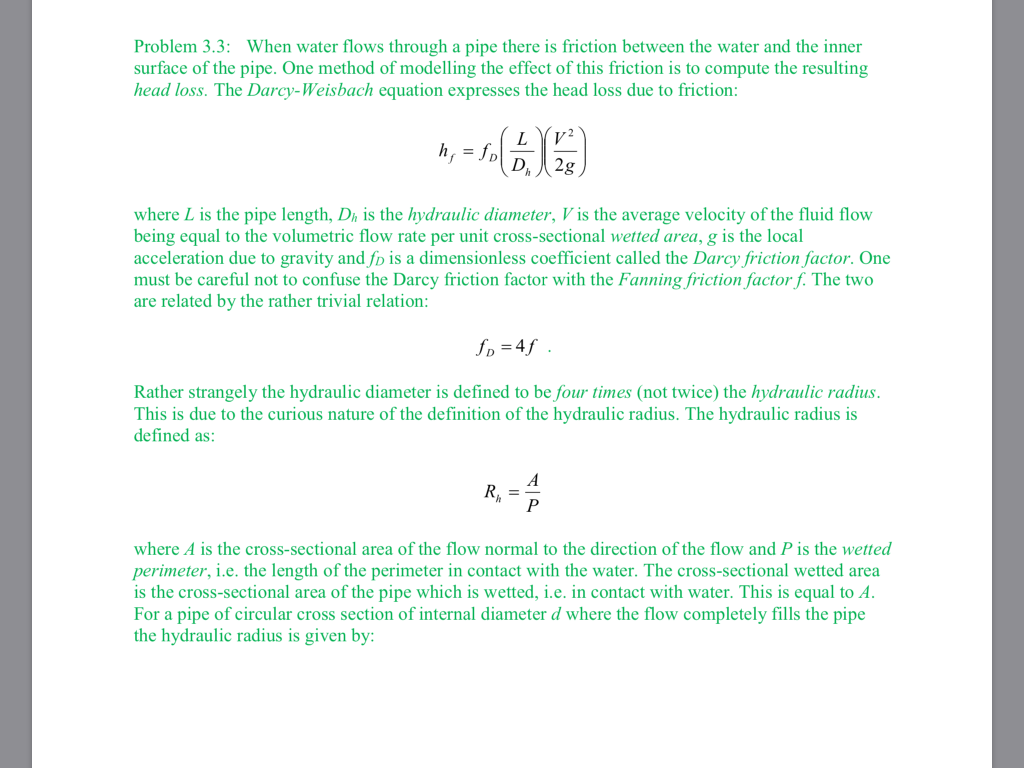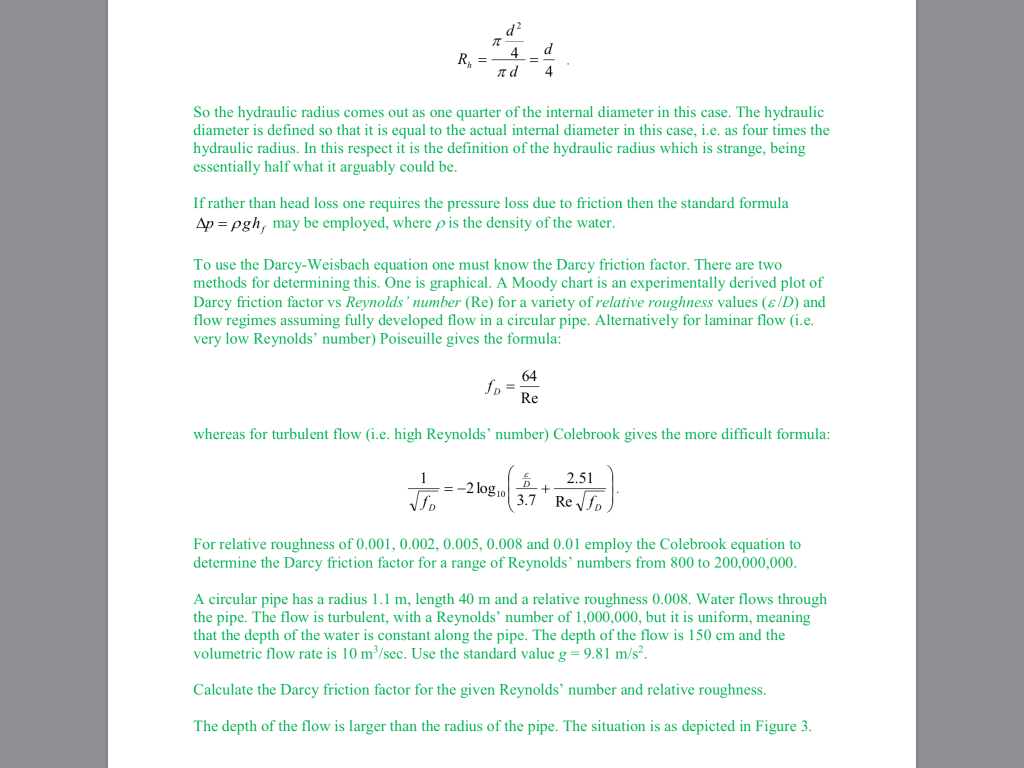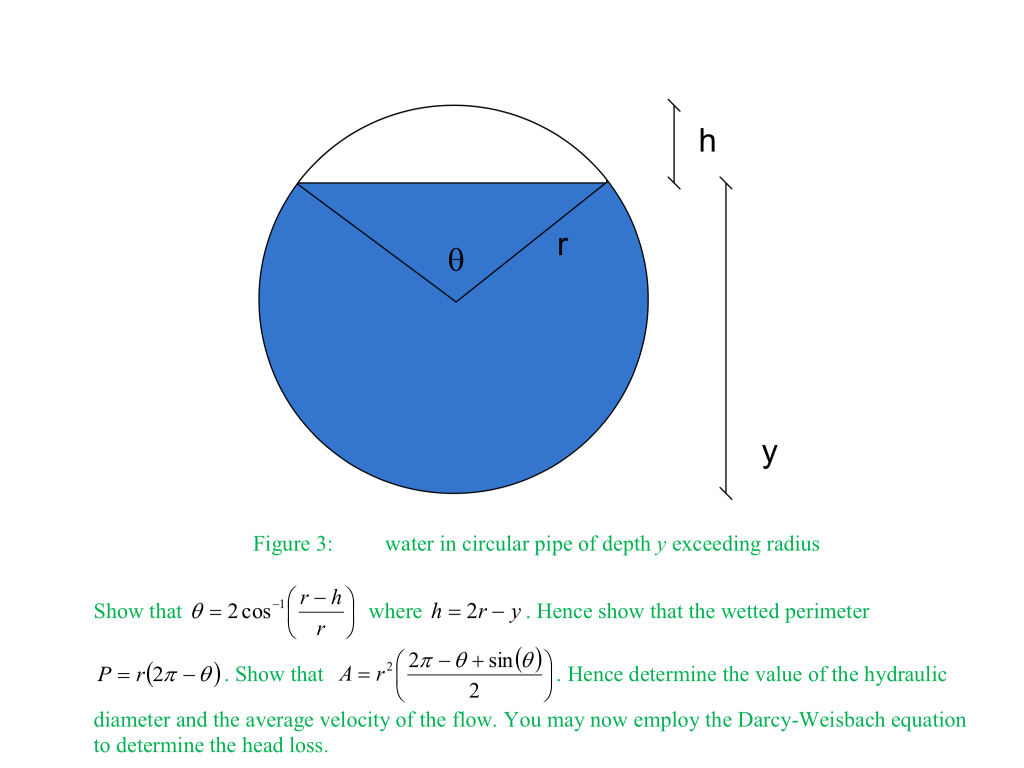Show all steps on matlab please


Problem 3.3: When water flows through a pipe there is friction between the water and the inner surface of the pipe. One method of modelling the effect of this friction is to compute the resulting head loss. The Darcy-Weisbach equation expresses the head loss due to friction: where L is the pipe length, Dh is the hydraulic diameter, Vis the average velocity of the fluid flow being equal to the volumetric flow rate per unit cross-sectional wetted area,g is the local acceleration due to gravity and fo is a dimensionless coefficient called the Darcy friction factor. One must be careful not to confuse the Darcy friction factor with the Fanning friction factor f. The two are related by the rather trivial relation: f-4f Rather strangely the hydraulic diameter is defined to be four times (not twice) the hydraulic radius This is due to the curious nature of the definition of the hydraulic radius. The hydraulic radius is defined as: where A is the cross-sectional area of the flow normal to the direction of the flow and P is the wetted perimeter, i.e. the length of the perimeter in contact with the water. The cross-sectional wetted area is the cross-sectional area of the pipe which is wetted, i.e. in contact with water. This is equal to A For a pipe of circular cross section of internal diameter d where the flow completely fills the pipe the hydraulic radius is given by nd 4 So the hydraulic radius comes out as one quarter of the internal diameter in this case. The hydraulic diameter is defined so that it is equal to the actual internal diameter in this case, i.e. as four times the hydraulic radius. In this respect it is the definition of the hydraulic radius which is strange, being essentially half what it arguably could be If rather than head loss one requires the pressure loss due to friction then the standard formula Ap pgh, may be employed, where p is the density of the water To use the Darcy-Weisbach equation one must know the Darcy friction factor. There are two methods for determining this. One is graphical. A Moody chart is an experimentally derived plot of Darcy friction factor vs Reynolds number (Re) for a variety of relative roughness values (ID) and flow regimes assuming fully developed flow in a circular pipe. Alternatively for laminar flow (i.e very low Reynolds' number) Poiseuille gives the formula: 64 whereas for turbulent flow (i.e. high Reynolds' number) Colebrook gives the more difficult formula 1*-2log1o 3.1 For relative roughness of 0.001, 0.002, 0.005, 0.008 and 0.01 employ the Colebrook equation to determine the Darcy friction factor for a range of Reynolds' numbers from 800 to 200,000,000 A circular pipe has a radius 1.1 m, length 40 m and a relative roughness 0.008. Water flows through the pipe. The flow is turbulent, with a Reynolds' number of 1,000,000, but it is uniform, meaning that the depth of the water is constant along the pipe. The depth of the flow is 150 cm and the volumetric flow rate is 10 m3/sec. Use the standard value g 9.81 m/s Calculate the Darcy friction factor for the given Reynolds' number and relative roughness. The depth of the flow is larger than the radius of the pipe. The situation is as depicted in Figure 3 Figure 3: water in circular pipe of depth y exceeding radius show that -2 cos-1(r-h ) P r(27-). Show that A-r2(2-0+ where h- 2r-y. Hence show that the wetted perimeter sin() Hence determine the value of the hydraulic diameter and the average velocity of the flow. You may now employ the Darcy-Weisbach equation to determine the head loss Problem 3.3: When water flows through a pipe there is friction between the water and the inner surface of the pipe. One method of modelling the effect of this friction is to compute the resulting head loss. The Darcy-Weisbach equation expresses the head loss due to friction: where L is the pipe length, Dh is the hydraulic diameter, Vis the average velocity of the fluid flow being equal to the volumetric flow rate per unit cross-sectional wetted area,g is the local acceleration due to gravity and fo is a dimensionless coefficient called the Darcy friction factor. One must be careful not to confuse the Darcy friction factor with the Fanning friction factor f. The two are related by the rather trivial relation: f-4f Rather strangely the hydraulic diameter is defined to be four times (not twice) the hydraulic radius This is due to the curious nature of the definition of the hydraulic radius. The hydraulic radius is defined as: where A is the cross-sectional area of the flow normal to the direction of the flow and P is the wetted perimeter, i.e. the length of the perimeter in contact with the water. The cross-sectional wetted area is the cross-sectional area of the pipe which is wetted, i.e. in contact with water. This is equal to A For a pipe of circular cross section of internal diameter d where the flow completely fills the pipe the hydraulic radius is given by nd 4 So the hydraulic radius comes out as one quarter of the internal diameter in this case. The hydraulic diameter is defined so that it is equal to the actual internal diameter in this case, i.e. as four times the hydraulic radius. In this respect it is the definition of the hydraulic radius which is strange, being essentially half what it arguably could be If rather than head loss one requires the pressure loss due to friction then the standard formula Ap pgh, may be employed, where p is the density of the water To use the Darcy-Weisbach equation one must know the Darcy friction factor. There are two methods for determining this. One is graphical. A Moody chart is an experimentally derived plot of Darcy friction factor vs Reynolds number (Re) for a variety of relative roughness values (ID) and flow regimes assuming fully developed flow in a circular pipe. Alternatively for laminar flow (i.e very low Reynolds' number) Poiseuille gives the formula: 64 whereas for turbulent flow (i.e. high Reynolds' number) Colebrook gives the more difficult formula 1*-2log1o 3.1 For relative roughness of 0.001, 0.002, 0.005, 0.008 and 0.01 employ the Colebrook equation to determine the Darcy friction factor for a range of Reynolds' numbers from 800 to 200,000,000 A circular pipe has a radius 1.1 m, length 40 m and a relative roughness 0.008. Water flows through the pipe. The flow is turbulent, with a Reynolds' number of 1,000,000, but it is uniform, meaning that the depth of the water is constant along the pipe. The depth of the flow is 150 cm and the volumetric flow rate is 10 m3/sec. Use the standard value g 9.81 m/s Calculate the Darcy friction factor for the given Reynolds' number and relative roughness. The depth of the flow is larger than the radius of the pipe. The situation is as depicted in Figure 3 Figure 3: water in circular pipe of depth y exceeding radius show that -2 cos-1(r-h ) P r(27-). Show that A-r2(2-0+ where h- 2r-y. Hence show that the wetted perimeter sin() Hence determine the value of the hydraulic diameter and the average velocity of the flow. You may now employ the Darcy-Weisbach equation to determine the head loss









